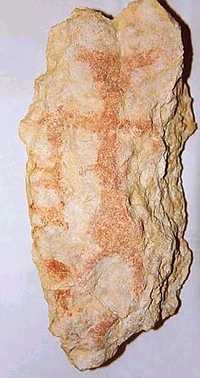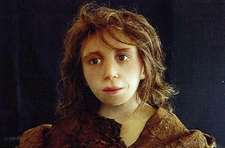My brother and I, growing old, are trying to figure out how we got to be like we are and how the world got to be like it is. He has been concentrating on working back in time and space from now, here, to Quebec and 1662. I started from then, Quebec and worked forward. I met Don and mom in the Folle Avoigne region of the Old Northwest Territory in 1796 and we found more questions, enough to fill all our lives with magic, mystery and joy. Then, caught by a sense of cycles of time and space I turned back. I have been going back ever since. Now I turn again to make story and myth out of this journey of mind in time. The telling is begun, though the mystery deepens with each new finding. It is imagining it all that I hope for; In the imagining we may come to feel the hows of us and it.
I suppose it begins with a painting and some meetings between Cromagnons and Neandertals in the Fumane Cave near Verona ( 34,500 to 30,000 BC) or with the painters in Chauvet-Pont d'Arc cave (28,340 to 30,410 BC).
|
|
This man looks like one of my dad's uncles from Liguria. The pattern of hair on my body apes his. We are, on that side, hairy, stocky, tribal folk; not as well muscled as this, our ancestor; civilized over time by the bell beaker people, Phonecians, Celts, Greeks, Romans, Franks, Moors and all their spawn. He is no relation at all, except in the imagining. He is imagined in the 1920's, a time when immigrants from southern and eastern Europe were seen as more primitive, by those who imagined Neandertals and made models for museums. But here in my imaginings, I claim him; even though the DNA might not permit his breeding with the Cromagnons that will prevail, he looks like one of us. Wrapped in skin and carrying the antler, he is ready to worship the god worshipped by my Santoni ancestors whose 16000 year old image is found on the wall of the Cave of the Three Brothers in France, or that his Cromagnon/Neandertal antecendants may have painted on the wall of the Fumane Cave near present day Verona 39000 years ago. Ready to begin 39,000 years of battling and mating with the other new arrivals in his part of the world or arriving in somebody else's partof the world to give battle and to mate. He learns to live with Phonecians and Celts, is overrun by a tribe that claims descendance from twins raised by wolves. He will shape shift in story, song and myth, and literally. DNA and selection are dancing their dance. It is Terramar time, Landsea time. (Even as we try to name the time we slip into the Latin that will come to tell the story of victors and victims.) His clan will be wolf. His language is non Indo-European. All the conquerers will rename and reshape him and his gods. As the Romans find him as a Ligurian or a Parsii or a Santoni, they name his god Cerunnos, the horned one, who comes among the Brythonic Celts to preside over the underworld as Lord of Death. His passing to the underworld is celebrated in the seasonal festivals of Samhain and Beltain("Summer's End" and May Eve) He passes with his antlers on November 1 and he is risen, growing new horns, on May 1, when all is renewed in Spring. According to Morning Glory Zell, Cernunnos "appears to have been a strong yet gentle god who was especially popular with men." He is a friend of the Greenman. As the Romans find Jesus they will name this god of the Celtic locals Satan. And all our ancestors will pay for worshipping him, the Greenman, and their consort, mother earth. But the descendants of this man with an antler, will do what they must to endure all these conquerers, for they were and are of the seasons and the earth, living close to their land among the trees. They will keep their own counsel and render unto Ceasar. |
|
By the Way, we're not the only ones trying to imagine ancestors. Hear the pros sing their song of uncertainty:
"...if we assume that the earliest remains of indisputably modern humans, rather than the first Aurignacian artifacts, mark the beginning of modern humans in Western Europe, it becomes possible that Neanderthals may have evolved into modern humans in some regions. In Germany, for example, the earliest undeniably modern humans -- the 31,000-year-old remains from Stetten and Kelsterbach -- are preceded by remains from the Feldhofer caves and Hahnöfersand that are difficult to classify as to human type. Though most scholars would probably disagree, these earlier individuals might have belonged to a population evolving from Neanderthals into modern humans. The possibility of such an evolution would end, however, if the 44,000-year-old individual from Feldhofer turned out to be a modern human".
Scott J. BrownOur Daughter Sister Cousin
|
Courtesy of Christoph P.E. Zollikofer and the Institute of Anthropology, University of Zürich-Irchel, Switzerland.) |
At Lagar Velho in central Portugal a rock shelter site yielded the remains of a four-year-old Neanderthal child, reconstructed here. He looks a little like my children and maybe even a little more like my niece who seeks to return to the land and a communal way living like her mom and dad's, like her Métis forebearer's, like those in the woods on the banks of the Boutonne, like those in the oppidum at Pian dei Preti, like the clans in the Fumane or Chauvet caves or Gorham's Cave, at Gibraltar, near the Devil's Tower. From the point of view of all the civilizers,from Cromagnon to Neo-Conservative, they all worshiped at the Devil's towers. The arguments about whether or not Neanderthals were really our ancestors, or a separate species, are vaguely reminiscent of what Cain might have said about his big brained brother Able. |
The imagining continues with the Carthaginians and the Punic wars. Carthage and Rome out to bring the benefits of their respective civilizatiiions to each other. (Controlling trade was just a beneficial side effect. The real issue was civilizing savages, pagans, abos, natives, barbarians, brutes.) Which brought Hannibal Barca across the Alps to ally with the Ligurians. Together they tried to civilize the spawn of the twin sons of a a she-wolf, who had come to name themselves after one of those sons, Romulus. It is the defining moment for the natives of western Cisapline Gaul. They cast their lot with losers.
And it wasn't the Durands then, it was the Bacigalupo's. Who were they then? Actually they were like the Carthaginians, descendants of the Phonecian colonists , long time sea going traders, who settled with the neolithic natives (cave painters) of the region, then run into the Celts. All of them melded becoming the Ligurians and spreading across most of the Riviera and northern Iberia, worshipping Baal. Pagans all to the Romans. The Proto Bacigalupos were concentrated in the hills above Genoa. Genoa began as a Phonecian settlement and the European north met the Nort African south in its harbor and on its streets. The hill folk met their neighbors in trade and labor. Even then they were stone workers making slate tables to entertain Greek traders. By 158 BC the Romans decide to deal once and for all with these Celto-Ligurian Phonecian Basques and overan their oppida in the hills above Genoa. They relocated some of the survivors to slate mines in easternmost Tuscany. It was the first time my ancestors were sent to a reservation. The Bacigalupos mined slate in Liguria and Tuscany well into the twentieth century. Once composite blackboards and tiles began to replace slate boards and tiles the market collapsed and the Bacigalupos colonized North America from coast to coast. Look em up in phone books. There is a Katlin Bacigalupo living on the Iron Range. I saw her name on Duluth's KDAL McDonald's birthday club last week. I'm sure she is a cousin of sorts and wonder at finding her so close.




